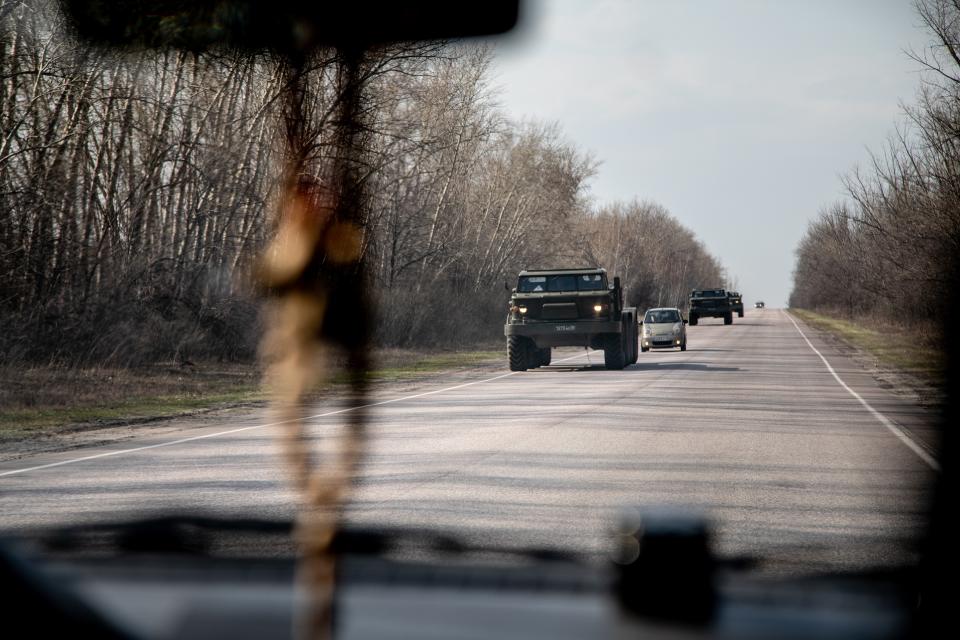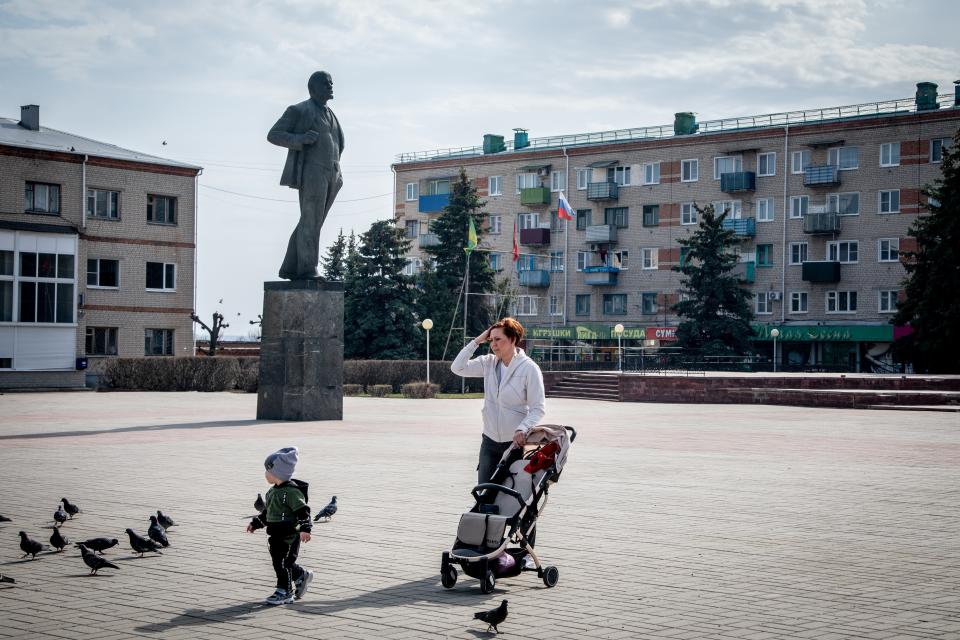Do the Russians want a war? Tanks, guns, and a new military camp on Ukraine’s doorstep

Rows of freshly pitched tents stretch back beyond the horizon. War propaganda posters flank the first line of them: “The motherland calls,” they read. Where the posters and canvas end, fake foliage begins – concealing what appears to be heavy weaponry of various descriptions.
The field camp, located just outside the southern city of Voronezh, is perhaps the most ominous sign of Russia’s latest intentions for Ukraine.
The Independent witnessed how it was able to absorb huge quantities of hardware. Perhaps 10 large diesel fuel tankers follow the gravel road leading from the Beryozhka holiday home settlement, past dozens of soldiers in training, before turning left to disappear into its green labyrinth. A column of lorries and light military vehicles is gobbled up soon after.
Located about 250km from the Ukrainian border, the Beryozhka camp was first discovered by the Conflict Intelligence Team (CIT), a group of Russian open-source researchers.

Using photos, videos and satellite images, CIT not only found the camp, but were able to document how heavy weaponry was first offloaded at two nearby train stations. They also suggested other temporary camps could be located further south, even nearer the Ukrainian border, around the towns of Ostrogozhsk and Valuyki.
Over Monday and Tuesday, The Independent was able to confirm the bulk of the CIT findings, observing military traffic between the Maslovka train station and Beryozhka camp.
This reporter noted two columns of military vehicles around Ostrogozhsk, both accompanied by military police; serious disruptions on the local railway network, especially at night; trains carrying tanks, cannon and other heavy equipment; and heightened military presence all across the region, especially on the roads immediately around the train stations and suspected camps.

But beyond the obvious order to mobilise, it is unclear what exactly Russia may be preparing for. Far less clear is whether Russians themselves will support any serious military campaign.
The Beryozhka camp is further away from the border than Russian camps set up at the height of fighting in 2014-15. But its size, and conspicuous position on a level just across from Kharkiv, Ukraine’s second city, are menacing enough for Kiev. The camp is located north of the Donbas conflict zone, and any supposed Ukrainian offensive against which the Kremlin is claiming to be defending.
Russia also appears to be amassing significant forces in Crimea, with some speculation mounting about an operation to regain control of a vital water canal linked to the Ukrainian mainland.
On Monday, CIT reported that equipment from the 76th Guards Air Assault Division had appeared on the disputed peninsula. The paratrooper unit played a significant shadow role in the Ukrainian conflict over 2014-15, with dozens of its members reported dead, and buried in secret funerals.

On Tuesday, following several weeks of inconsistent explanations, defence minister Sergei Shoigu was forced into an admission of sorts. Russia was indeed concentrating new forces at Ukraine’s border, he said.
But the unannounced military activity was a response to the “threatening military activity of Nato,” he said, “especially in Poland and in the Baltic states.” The extraordinary exercises are due to come to an end in two weeks, he said.
Nato, in response, urged Moscow to call off what it described as the “largest massing of Russian troops since the annexation of Crimea”.
Russia’s military posture certainly appears aggressive for a country that claims to be acting to avoid war. Nonetheless, most experts remain sceptical about the prospect of a major direct confrontation between Russia and Ukraine.
Speaking with The Independent from Kiev by phone, Ukraine’s former foreign minister Pavlo Klimkin says he believes the current military build-up is about Russia “raising the stakes” ahead of negotiations with the US, Germans and the French. Vladimir Putin is acting “tactically” to get ahead of issues like sanctions and technology transfer further down the line.
“The Russians want capitulation,” he says, “but they want it without war.”
The longtime minister did not rule out a provocation in Crimea, but did suggest an incursion towards Kharkiv would be “mad”, and provoke a guerrilla fightback that Moscow would regret. “That doesn’t mean the mood in Kharkiv isn’t anxious,” he adds.

A sense of foreboding appears to be present among a significant section of the Russian population too. It is notable that much of the footage that allowed CIT to build up their picture is accompanied by complaints and groans from those shooting it – not by the patriotic cheering often evident in videos recorded at the peak of fighting between 2014 and 15.
Lev Gudkov, head of the Levada Centre, the country’s last remaining independent pollsters, says the polling numbers show Russians feel a growing sense of helplessness and fear. Now, 62 per cent are “worried” about a “big war”, he says, which represents a massive leap of 20 per cent over recent years. Only 15 per cent say they are ready for such a confrontation.
That is not to say that people understand what is actually happening on Russia’s borders. That, he says, is the real success of state propaganda, which has over recent weeks adopted an almost blanket anti-Ukrainian tone: “Every hour, every day, the coverage is relentless, and that’s why it’s effective.”
In Ostrogozhsk, just 150km from the Ukrainian border, Nadezhda, surname withheld, 63, tells The Independent she believes there is “no risk” of war developing. The former doctor has relatives in Kiev, she says, and no one there was planning an attack. But the Russian military is doing nothing out of the ordinary either. Reports of military build-up were fake news.

“I have a flat on the edge of the town, I see everything, and I can tell you the reports are wrong,” she says.
Across the road on the main square, with a statue of Lenin bearing down, a young mother offers an alternative opinion; she declined to say her name. Heavy weaponry is indeed being transported in and around town, she says. But it “wasn’t worth writing about”, and wasn’t inconsistent with the military exercises that sometimes take place here.
“They clatter through here every year,” she tells The Independent.
“War or no war, things will be decided without us. And I’d suggest you do something more useful than counting guns.”
Read More
Greensill: ‘All decisions taken by the bank were made independently’, minister says
Germany sees record vaccinations amid hospital warning
Estonia closes road for a month at night so frogs and toads can cross

 Yahoo News
Yahoo News 